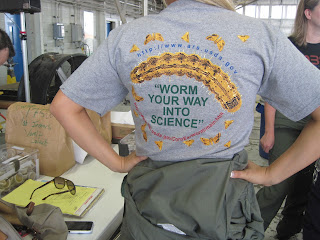We flew 2 separate loads - one group on Tuesday and another on Wednesday.
Each load had the following:
*40 larvae at instar 1 (baby worms - tiny, about 3 mm long)
*40 larvae at instar 4 (large worms - about 20 mm (2 cm) long)
*40 pupae (worms that have gone into the cocoon state)
Our ground control group of worms consisted of:
*80 larvae instar 1
*80 larvae instar 4
AFTER THE FLIGHT:
Upon landing we noticed all the larvae (worms) were very lethargic and looked dead. Many of them were lying upside down and not moving. After one day back on the ground we inspected all the specimens. After gathering the observations we noticed a trend! Surprisingly, the number of dead specimens was no different from the control group. But, we did notice that the flight larvae/instar 4 had pupated (turned into cocoons) at a much slower rate than the ones that had NOT been flown. The flight appears to have delayed the pupation time (time needed to turn into a cocoon).
(Above) A freshly formed pupa - the worm has begun making it's cocoon!
This pupa above has been injured by the flight and is oozing some white fluid!
A larvae that is very lethargic after the flight!
What happens next?
We are really curious about the effects of the flight on the cocoons. We think that the cocoons will not emerge with as many healthy moths as the control group. We expect to see possible mutations and abnormalities as well. The cocoons should have moths emerge in the next few days.






No comments:
Post a Comment